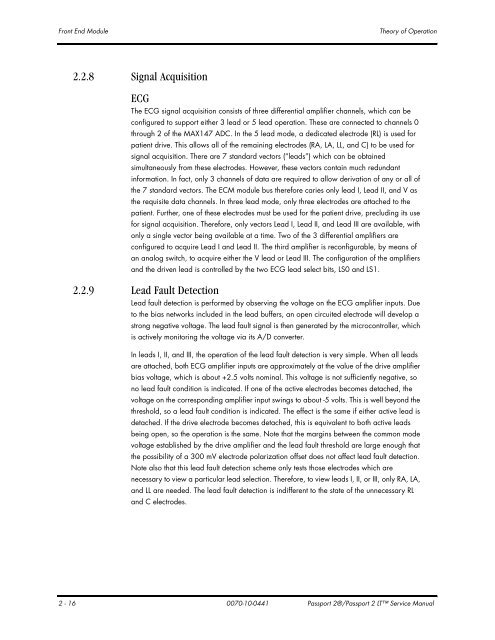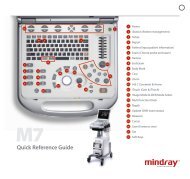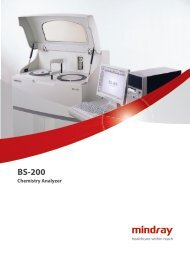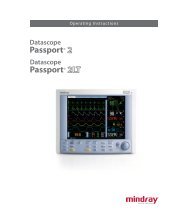Datascope Passport - Mindray
Datascope Passport - Mindray
Datascope Passport - Mindray
Create successful ePaper yourself
Turn your PDF publications into a flip-book with our unique Google optimized e-Paper software.
Front End Module Theory of Operation<br />
2.2.8 Signal Acquisition<br />
ECG<br />
The ECG signal acquisition consists of three differential amplifier channels, which can be<br />
configured to support either 3 lead or 5 lead operation. These are connected to channels 0<br />
through 2 of the MAX147 ADC. In the 5 lead mode, a dedicated electrode (RL) is used for<br />
patient drive. This allows all of the remaining electrodes (RA, LA, LL, and C) to be used for<br />
signal acquisition. There are 7 standard vectors (“leads”) which can be obtained<br />
simultaneously from these electrodes. However, these vectors contain much redundant<br />
information. In fact, only 3 channels of data are required to allow derivation of any or all of<br />
the 7 standard vectors. The ECM module bus therefore caries only lead I, Lead II, and V as<br />
the requisite data channels. In three lead mode, only three electrodes are attached to the<br />
patient. Further, one of these electrodes must be used for the patient drive, precluding its use<br />
for signal acquisition. Therefore, only vectors Lead I, Lead II, and Lead III are available, with<br />
only a single vector being available at a time. Two of the 3 differential amplifiers are<br />
configured to acquire Lead I and Lead II. The third amplifier is reconfigurable, by means of<br />
an analog switch, to acquire either the V lead or Lead III. The configuration of the amplifiers<br />
and the driven lead is controlled by the two ECG lead select bits, LS0 and LS1.<br />
2.2.9 Lead Fault Detection<br />
Lead fault detection is performed by observing the voltage on the ECG amplifier inputs. Due<br />
to the bias networks included in the lead buffers, an open circuited electrode will develop a<br />
strong negative voltage. The lead fault signal is then generated by the microcontroller, which<br />
is actively monitoring the voltage via its A/D converter.<br />
In leads I, II, and III, the operation of the lead fault detection is very simple. When all leads<br />
are attached, both ECG amplifier inputs are approximately at the value of the drive amplifier<br />
bias voltage, which is about +2.5 volts nominal. This voltage is not sufficiently negative, so<br />
no lead fault condition is indicated. If one of the active electrodes becomes detached, the<br />
voltage on the corresponding amplifier input swings to about -5 volts. This is well beyond the<br />
threshold, so a lead fault condition is indicated. The effect is the same if either active lead is<br />
detached. If the drive electrode becomes detached, this is equivalent to both active leads<br />
being open, so the operation is the same. Note that the margins between the common mode<br />
voltage established by the drive amplifier and the lead fault threshold are large enough that<br />
the possibility of a 300 mV electrode polarization offset does not affect lead fault detection.<br />
Note also that this lead fault detection scheme only tests those electrodes which are<br />
necessary to view a particular lead selection. Therefore, to view leads I, II, or III, only RA, LA,<br />
and LL are needed. The lead fault detection is indifferent to the state of the unnecessary RL<br />
and C electrodes.<br />
2 - 16 0070-10-0441 <strong>Passport</strong> 2®/<strong>Passport</strong> 2 LT Service Manual












